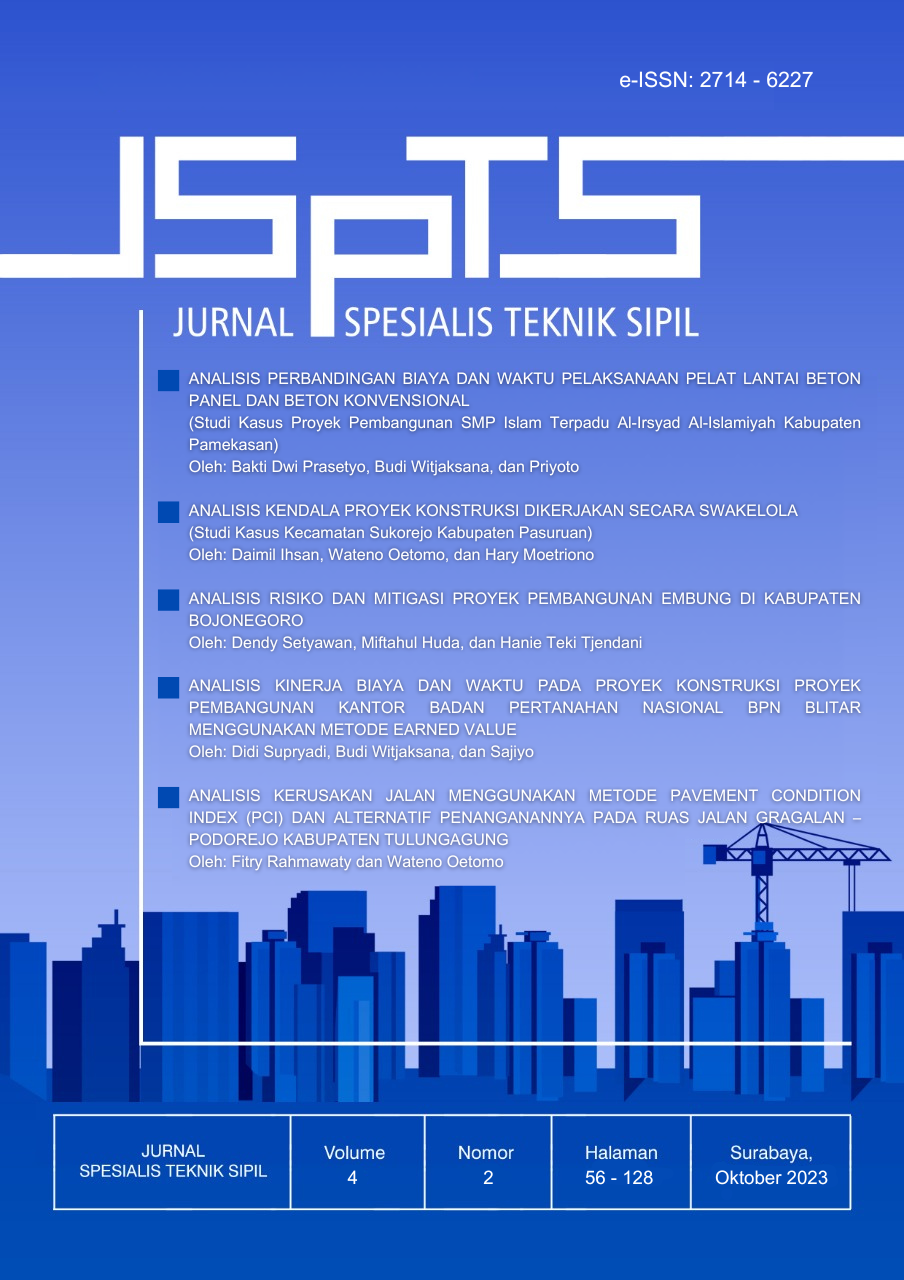Analisis Risiko dan Mitigasi Proyek Pembangunan Embung di Kabupaten Bojonegoro
DOI:
https://doi.org/10.30996/jspts.v4i2.10686Keywords:
Embung, Factor analysis, Risk, Natural disastersAbstract
Abstract
Development of embung is one of the conservative ways to cope with floods. The development process of embung cannot be separated from risk, in order to minimize the impact of risk, risk identification and mitigation are carried out to increase the success of the project. This study uses a factor analysis method, to determine risk factors. The risk impact matrix diagram is used to map the risk index. Risk response to risk impact matrix mapping is done to minimize losses. Mitigation is carried out on risk factors that are classified as high and significant risk, which have the potential to hamper the smooth running of the project. The results of the identification of risk variables in this study there are 25 risk agents with 8 categories of risk factors, namely: external factors, work procedures, resources, methods, supervision, material, process errors, and labor. The highest priority for handling is the occurrence of natural disaster risk with the risk index of 19.995, and equipment that is not feasible 19.95. Construction of temporary levees was carried out and made the provisions of the detailed equipment specification procedure carried out in response to the dominant risk variable.
Downloads
References
Badan Perencanaan Pembangunan Daerah Kabupaten Bojonegoro (2013). Rencana Pembangunan Jangka Menengah Daerah
Djojosoedarso, S. (2003). Prinsip-Prinsip Manajemen Resiko dan Asuransi, Edisi Revisi. Jakarta: Salemba Empat.
Erizal, 2016. Manajemen Proyek Konstruksi. Bogor : Institut Pertanian Bogor
Henong S B, Lake R Ch, Malut M G, 2017. Identifikasi Faktor-Faktor Risiko Padabendungan Raknamo Di Kabupaten Kupang. Konferensi Nasional Teknik Sipil dan Infrastruktur – I, Jurusan Teknik Sipil Universitas Jember, 30 Oktober 2017
Kasidi, 2010. Manajemen Resiko. Jakarta : Ghalia Indonesia
Mukti F F, 2018. Analisa Faktor Risiko Pada Proyek Konstruksi Jembatan Mahakam IV Samarinda. ejurnal.untag-smd.ac
Muka I W, 2013. Analisis Risiko pada Proyek Pembangunan Parkir Basement Jalan Sulawesi Denpasar. Jurnal MKTS, 2013
Maryono, A. (2005). Menangani banjir,kekeringan dan lingkungan. Yogyakarta:Gadjah Mada University Press.
Nurhadi, Sumunar D R S, dan Khotimah N, (2016). Analisis Kerentanan Banjir Dan Penanggulangan Bencana Di Daerah Aliran Sungai Code Kota Yogyakarta : Jurnal Penelitian Saintek, Vol. 21, Nomor 2, Oktober 2016
PP Nomor 27 Tahun 1999 Pasal 3 ayat 1
Rivai. 2014. Manajemen Sumber Daya Manusia untuk Perusahaan, Edisi ke 6. Depok : PT. Raja Grafindo Persada
Sari E, 2016. Analisis Risiko pada Proyek Pekerjaan Jembatan Sidamukti - Kadu di Majalengka dengan Metode FMEA dan Decision Tree. Jurnal J-Einstec Vol , No 1, 2016
Sofyan I, 2004. Manajemen Resiko. Jakarta : Graha Ilmu
Tjakra J dan Sangari F, 2011. Anlisis Risiko pada Proyek Kontruksi Perumahan di Kota Manado. Jurnal Ilmiah Media Enggineering Vol , No 1, 2011
Wahyuni, S. (2014). Perbandingan Metode MOCK dan NRECA untuk Pengalihragaman Hujan Ke Aliran. Jurnal REKAYASA , 13, 602-624.
Wibisana D A, 2016. Analisa Risiko Kecelakaan Kerja Proyek Bendungan Tugu Kabupaten Trenggalek Menggunakan Metode Fmea (Failure Mode And Effect Analysis) Dan Metode Domino. Tugas Akhir, Teknik Sipil, ITS Surabaya.












